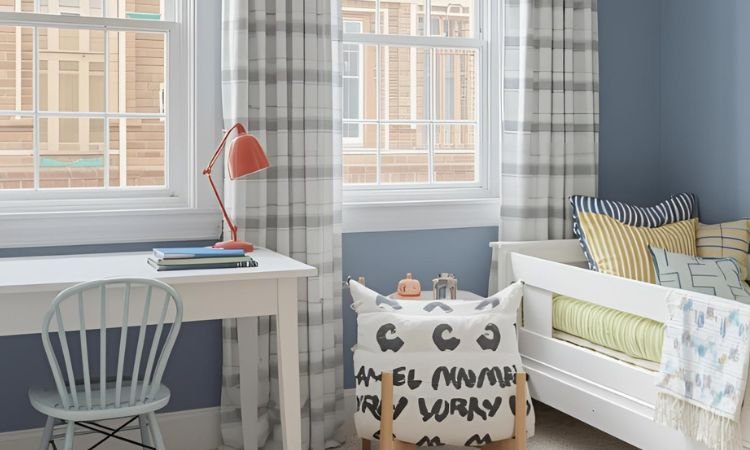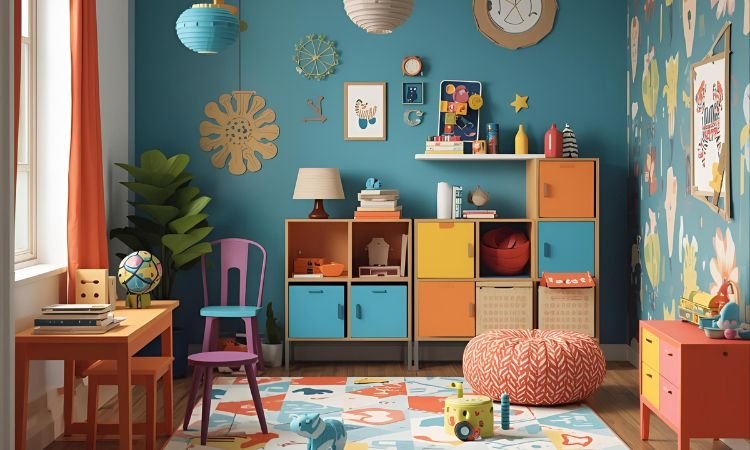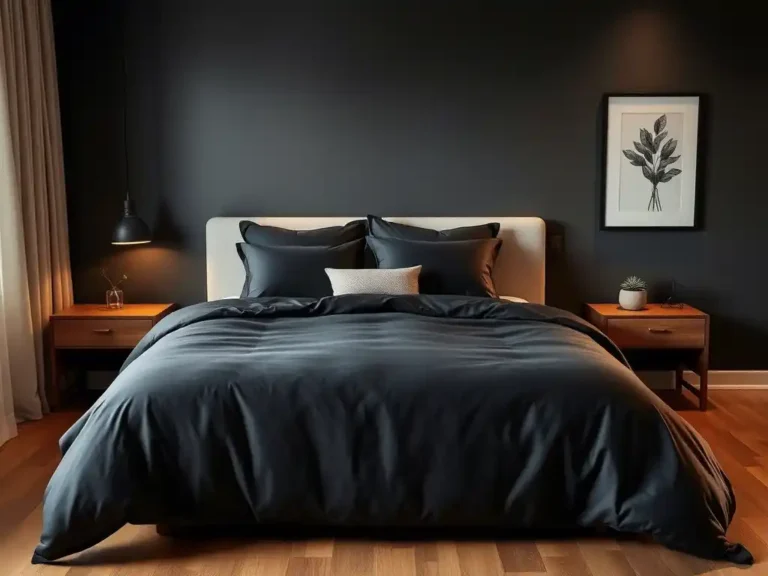Cute & Clever Kids Room Ideas for Play, Study, and Sleep

Creating a kids’ room that truly works can feel like a constant battle against clutter, outgrown themes, and conflicting needs for play, sleep, and study. A space that isn’t thoughtfully designed often leads to chaos, limits creativity, and fails to adapt as children grow. The goal is to build an environment that supports their development, fosters imagination, and remains organized amidst daily activity.
This article offers practical solutions to common room design challenges, turning overwhelming spaces into inviting and adaptable havens. We’ll explore 13 smart strategies that blend playful elements with functional necessities, ensuring that every corner serves a purpose and sparks joy. Get ready to discover clever ways to maximize space, organize belongings, and personalize a room that kids will love.
These selections prioritize safety, durability, and a balance of fun and practicality, demonstrating that a child’s room can be both magical and manageable.
Guiding Principles for Dynamic Kids’ Rooms
- Adaptability for Growth: Design elements should evolve with your child’s changing ages and interests. It’s like flexible architecture where components can be swapped. Investing in adaptable pieces reduces the need for frequent overhauls.
- Maximize Every Inch: Clever storage and multi-functional furniture are essential in rooms often smaller than adult spaces. It’s like smart packing where every item serves a purpose. Efficient use of space prevents clutter and promotes play.
- Safety Comes First: All furniture must be sturdy, anchored if necessary, and free from hazards. It’s like a secure playground where protection is the priority. Safe surroundings allow children to explore without risk.
- Reflect Their Personality: Incorporate your child’s favorite colors, characters, or hobbies into the room design. It’s like a personal gallery where their interests are on display. A personalized room fosters comfort and ownership.
13 Kids Room Ideas
Discover innovative ways to create organized, stimulating, and fun spaces for children.
1. Themed Adventure Zones
Design distinct areas within the room that follow a central theme, such as a jungle, outer space, or enchanted forest, using murals, bedding, and accessories. This sparks imaginative play and creates an immersive environment for daily adventures. It’s like building a mini-world where every detail tells a story.
Ensure the theme isn’t overly specific or childish, allowing it to adapt as your child grows; for example, a subtle forest theme can transition from woodland creatures to a more mature nature-inspired space. Choose durable, easy-to-clean materials for bedding and rugs.
2. Loft or Bunk Beds with Integrated Study/Play
Install a loft bed or bunk bed system that incorporates a desk, shelving, or a play area underneath. This intelligent use of vertical space is ideal for smaller rooms, providing separate zones for different activities. It’s like a compact multi-story living unit where every level has a function.
Select sturdy frames with secure ladders or stairs and ensure ample headroom for the child using the lower area. This design strategy effectively triples the usable floor space in a compact footprint.
3. Gallery Wall for Art & Photos
Create a dynamic gallery wall featuring your child’s artwork, favorite photographs, and inspirational prints, using frames that are easy to open and update. This celebrates their creativity and personal memories, making the space uniquely theirs. It’s like a rotating exhibition where their masterpieces are proudly displayed.
Use uniform frames for a cohesive look or mix different styles for an eclectic feel. Position the frames at a child-friendly height so they can easily admire their contributions.
4. Interactive Chalkboard or Whiteboard Wall
Designate a section of a wall for a chalkboard or whiteboard paint, giving children a dedicated surface for drawing, practicing letters, or imaginative play. This encourages creativity and provides an alternative to drawing on other surfaces. It’s like a giant sketchpad where ideas can flow freely.
Ensure the area is easily accessible and consider framing the section with trim to give it a finished look. Provide child-safe chalk or markers and an accessible eraser.
5. Smart Storage Solutions
Implement a variety of storage options like cubbies with fabric bins, pegboards for hanging items, under-bed drawers, and wall-mounted shelves to keep toys and books organized. This prevents clutter and teaches children organizational habits. It’s like a methodical filing system where everything has a designated place.
Label bins and shelves with pictures for younger children and words for older ones to encourage independent tidying. Choose storage units that are sturdy and easy for kids to access.
6. Cozy Reading Nook
Carve out a special corner with a comfortable beanbag chair, floor cushions, or a small armchair, accompanied by a soft rug and good lighting. This dedicated space encourages a love for reading and provides a quiet retreat. It’s like a personal sanctuary where stories come alive.
Ensure the lighting is bright enough for reading but also creates a warm, inviting glow. Pair it with accessible bookshelves to keep favorite books within easy reach.
7. Glow-in-the-Dark Ceiling Stars
Adorn the ceiling with glow-in-the-dark stars, planets, or constellations that illuminate at night, creating a magical atmosphere as they drift off to sleep. This adds a whimsical touch and can help alleviate fear of the dark. It’s like bringing the night sky indoors, where dreams take flight.
Apply them strategically to resemble actual constellations or simply scatter them for a charming effect. These can also be paired with a night light for subtle illumination.
8. Play Table with Built-In Storage
Incorporate a play table with drawers, cubbies, or a lift-top compartment for storing art supplies, building blocks, or small toys. This provides a dedicated surface for creative activities and easy cleanup. It’s like a versatile workstation where fun and function combine.
Choose a table that is sturdy and sized appropriately for your child’s age, ensuring comfortable seating. The integrated storage makes transitioning between activities smoother.
9. Wall Decals or Removable Wallpaper
Use colorful and engaging wall decals or removable wallpaper to introduce patterns, characters, or landscapes without the commitment of permanent paint. This allows for easy updates as your child’s interests change. It’s like a changeable backdrop where themes can shift effortlessly.
These options are perfect for renters or for parents who like to refresh the room’s look periodically. Ensure the decals are high-quality and easy to apply and remove without damaging walls.
10. Multi-Level Play Platforms
If space allows, create a raised platform with steps or a ramp, defining a play area while also offering hidden storage beneath. This adds architectural interest and imaginative play potential. It’s like a miniature stage where creativity can unfold.
Ensure all edges are rounded and surfaces are non-slip for safety. This concept works well for creating distinct zones in a larger room, such as a dedicated area for trains or dollhouses.
11. Custom Wardrobe with Kids’ Height Access
Design a closet system or wardrobe with clothes rails, shelves, and drawers positioned at your child’s height. This encourages independence in choosing outfits and putting away clothes. It’s like a personalized dressing room where self-sufficiency is promoted.
Include clear bins for smaller items and easy-to-reach hooks for bags or jackets. This setup helps teach organizational skills from an early age.
12. Fun Lighting Fixtures
Choose creative lighting fixtures that align with the room’s theme, such as a cloud-shaped lamp, a rocket pendant, or fairy lights draped around a canopy. This adds personality and provides essential illumination. It’s like adding jewelry to a room where light becomes decor.
Layer lighting with ambient overhead lights, task lighting for desks, and decorative night lights to create different moods and serve various functions throughout the day.
13. Rock Climbing Wall Section
Install a small, low rock climbing wall section with child-friendly grips on a sturdy wall. This provides an active outlet within the room, promoting physical development and coordination. It’s like an indoor playground where energy can be safely expended.
Ensure the wall is securely mounted to structural studs and place a thick crash mat or soft flooring underneath for safety. Always supervise children when they are using it.
Designing for Joy and Development
- Involve Your Child in Decisions: Let your child have input on colors, themes, or furniture choices. This fosters a sense of ownership and pride in their space. It’s like a collaborative design project where their voice is valued.
- Prioritize Open Space: While storage is crucial, ensure there’s still open floor space for active play and movement. It’s like an open canvas where imagination has room to roam. Uncluttered areas encourage creative activities.
- Regularly Declutter and Organize: Periodically go through toys and clothes with your child to donate or re-organize items. It’s like a seasonal refresh where functionality is maintained. This prevents overwhelm and keeps the space functional.
Frequently Asked Questions About Kids’ Room Design
How can I make a small kids’ room feel larger?
To make a small kids’ room feel larger, use light paint colors, maximize vertical space with loft beds or wall-mounted shelves, and choose multi-functional furniture like storage ottomans. Keep clutter to a minimum and use mirrors to create an illusion of depth.
Focus on strategic lighting to brighten the room, and select furniture with slender profiles rather than bulky pieces to maintain an airy feel.
What are good paint colors for kids’ rooms?
Good paint colors for kids’ rooms often include calming blues, soft greens, gentle yellows, or warm grays, which promote a serene atmosphere conducive to sleep and focus. Bright pops of color can be introduced through accessories, bedding, or accent walls.
Consider your child’s preferences, but balance vibrant choices with neutral tones to prevent the room from feeling too overstimulating or difficult to update later.
How do I design a room for two kids sharing?
When designing a room for two kids sharing, prioritize individual sleeping areas with bunk beds or two twin beds. Create designated personal spaces for each child, possibly with separate storage cubbies or desk areas.
Use a neutral base color for the room and let each child choose accessories or bedding that reflect their personality. Establish clear zones for play and rest to minimize conflicts.
How can I make a kids’ room safe?
To make a kids’ room safe, anchor all heavy furniture (dressers, bookshelves) to the wall to prevent tipping. Ensure cords from blinds or lamps are out of reach. Use child-safe window guards and outlet covers.
Choose non-toxic paints and finishes. Ensure all furniture has rounded edges where possible, and avoid small parts that could be choking hazards for very young children.
What kind of flooring is best for a kids’ room?
Durable, easy-to-clean flooring is best for a kids’ room. Options like low-pile carpet or carpet tiles offer softness and warmth, reducing noise. Hardwood or laminate flooring is easy to clean and good for allergies, though you might want to add soft rugs for play.
Vinyl flooring is another practical choice, known for its resilience and water resistance. Consider comfort for crawling and playing, as well as ease of maintenance.
Crafting Spaces Where Dreams Grow
Designing a kids’ room is an opportunity to craft a space that supports their journey from infancy through adolescence. By carefully considering functionality, safety, and personal expression, you create more than just a room; you build a backdrop for countless memories, imaginative games, and peaceful rest.
The thoughtful integration of smart storage, adaptable furniture, and inspiring themes ensures that their personal haven evolves with them, always feeling like a perfect fit.
Begin by identifying your child’s current needs and future growth, then select ideas that transform their room into a place of wonder and order. Remember, a well-designed space empowers them to play, learn, and dream without limits.
Which of these kids’ room ideas will you bring to life first? Share your favorite design concepts below!






